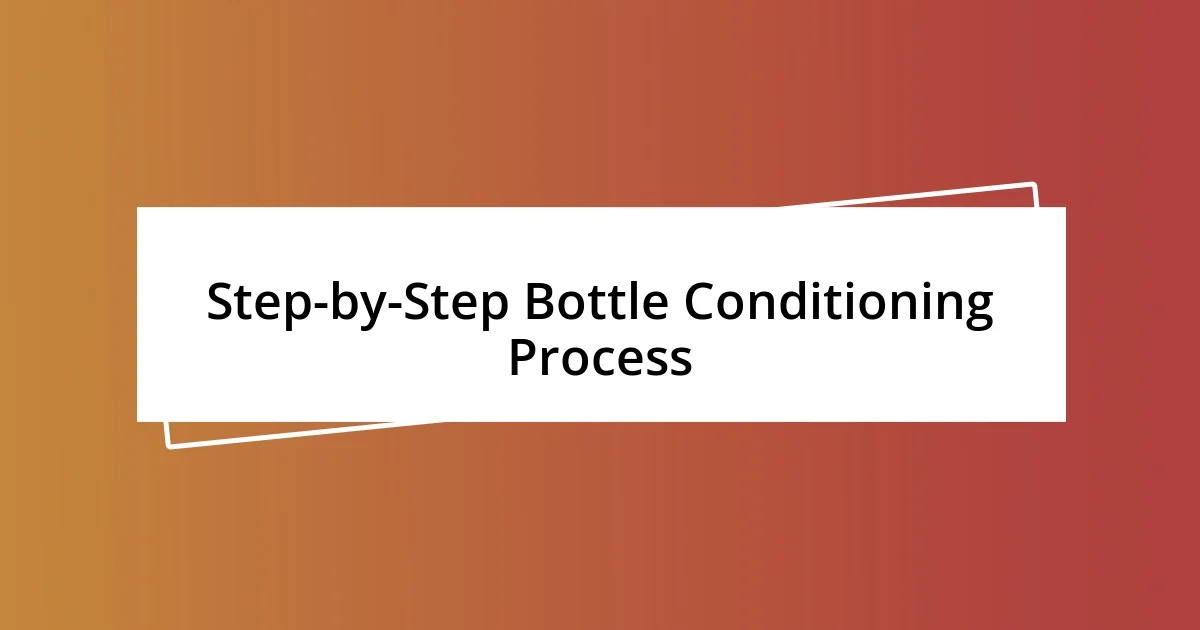Key takeaways:
- Bottle conditioning enhances beer’s carbonation and flavor, creating a unique experience with each bottle.
- Essential equipment includes clean bottles, caps, a capper, priming sugar, and a hydrometer for optimal results.
- Key mistakes to avoid are improper temperature control, inadequate sanitization, and rushing the conditioning process for the best outcome.

Understanding Bottle Conditioning
Bottle conditioning is a fascinating process that adds depth and character to beer. When I first learned about it, I remember feeling a mix of curiosity and excitement. The idea that a little bit of sugar and yeast could work wonders inside a sealed bottle was intriguing. Have you noticed how some beers seem to have that lively carbonation and a richer flavor? That’s the magic of bottle conditioning at work.
This method involves adding priming sugar to your beer just before sealing it in bottles. As the yeast consumes this sugar, it produces carbon dioxide and alcohol, creating natural carbonation. It feels almost like a personal conversation between the yeast and the beer, culminating in a beautifully crafted brew. Each bottle you open is a new experience, a little surprise that reflects the care you took during brewing.
From my experience, the results can vary quite a bit. I’ve had some batches that sparkled with vibrant effervescence and others that just fell flat, reminding me that patience is key. Have you ever taken a sip and felt the effervescent bubbles dance on your tongue? That’s the joy of bottle conditioning! You really get to appreciate the lengths we go through to create something special in each bottle.

Benefits of Bottle Conditioning
When it comes to the benefits of bottle conditioning, one standout aspect is the enhanced flavor profile. I still remember the first time I enjoyed a bottle-conditioned beer that had aged a bit. The complexity of flavors was like a symphony on my palate—each sip revealed something new and delightful. This maturation process allows the yeast to develop intricate flavors that you simply don’t get with forced carbonation methods.
Here are some key benefits of bottle conditioning:
- Natural Carbonation: The process creates a smoother mouthfeel and a softer carbonation that can feel more pleasant than artificially carbonated beers.
- Increased Depth of Flavor: The yeast continues to work on the beer, leading to richer, often more nuanced flavors as it matures in the bottle.
- Artisan Quality: Bottle conditioning imparts a craft feel to your brewing, showing that you’ve gone the extra mile to create something special.
Bottle conditioning also offers a unique connection between the brewer and the beer. I’ve found that each bottle becomes a tiny time capsule, evolving over weeks and months. It’s rewarding to sip on a bottle that I’ve crafted and notice how the bubbles have brought out hidden notes that weren’t as prominent right after bottling. The anticipation as the carbonation develops truly adds to the enjoyment of the brewing journey.

Essential Equipment for Bottle Conditioning
It’s easy to overlook the equipment needed for bottle conditioning, but let me tell you—it’s crucial to get it right. At the very least, you’ll need clean bottles, caps, and a priming sugar solution. I remember the first time I used a priming sugar calculator; it felt like unlocking a new level in my brewing. Knowing exactly how much sugar to add for the desired carbonation made a significant difference in my batches.
A bottle capper is another essential tool that I can’t stress enough. Initially, I tried sealing bottles without one, thinking it wouldn’t make much difference. Once I invested in a good bottle capper, my results improved dramatically—no more flat beers! That satisfying pop when you open a properly sealed bottle? I cherish that moment every time.
You might also want a hydrometer to measure the specific gravity of your beer before and after fermentation. Trust me, it’s not just for the pros. Having this tool in your brewing kit allows you to track fermentation progress, offering insights into how well your yeast is performing. Once, I discovered a high level of residual sugar due to stalled fermentation, prompting me to adjust my technique for future batches, which elevated my bottle conditioning game.
| Equipment | Purpose |
|---|---|
| Bottles | Holds the beer for conditioning |
| Bottle Caps | Seals the bottles to contain carbonation |
| Capper | Aids in securely sealing the bottles |
| Priming Sugar | Provides fermentation for carbonation |
| Hydrometer | Measures specific gravity of the beer |

Choosing the Right Ingredients
Choosing the right ingredients for bottle conditioning is a critical step that can dramatically influence your beer’s outcome. In my early brewing days, I learned this the hard way when I used standard sugar instead of priming sugar; the results were far less than satisfactory. It’s really about understanding how each ingredient impacts flavor and carbonation. Have you ever tasted a beer and wondered why some are so much livelier on the palate? The right priming sugar can create those effervescent bubbles that make each sip so enjoyable.
Another ingredient I find essential is the yeast. Utilizing a high-quality yeast strain can vastly improve the complexity of your brew. I remember trying a new ale yeast that not only enhanced the carbonation but also introduced hints of fruitiness I hadn’t anticipated. It made me realize just how transformative yeast is in the bottle conditioning process. I often ask fellow brewers, “Have you explored different yeast strains for your brews?” Those little changes can lead to extraordinary results.
Lastly, don’t overlook the importance of water quality in your brewing process. I used to think all water was the same, until I made a batch with filtered water and noticed an incredible difference in taste. The clarity and purity of the water can elevate your beer to new heights, creating that clean finish that highlights your carefully chosen ingredients. Always remember, each component you select plays a role in the final experience of your beer. What’s your go-to ingredient that makes all the difference? I’d love to hear your thoughts!

Step-by-Step Bottle Conditioning Process
When it’s time to start the bottle conditioning process, first, prepare your priming sugar solution. I like to heat water and dissolve the sugar in it—this little step made a world of difference for me. In my early attempts, I often tossed sugar directly into the bottles, hoping for the best; it didn’t yield the carbonation I was aiming for, and I learned the importance of this preparation firsthand.
After you’ve got your priming sugar solution ready, gently mix it into your beer. The trick here is to do it carefully, minimizing oxygen exposure. I recall a batch where I didn’t pay attention to this detail—I ended up with off-flavors that ruined what could have been a great brew. It’s a delicate balance to find, but ensuring the sugar integrates well while protecting the integrity of your beer is key to a successful conditioning.
Now, fill each bottle to the appropriate level, usually about an inch from the top, and seal them tightly. I remember a particularly frustrating session where I thought I’d perfectly filled my bottles, only to find several had overflows during conditioning. It’s these little nuances that remind me just how important attention to detail is in bottle conditioning. Have you experienced any mishaps while bottling? They can be instructive moments!

Common Mistakes to Avoid
It’s easy to underestimate the impact of temperature during bottle conditioning. I remember a batch I stashed away in a cooler, thinking it would be a controlled environment, only to find out later that it was too cold. The carbonation was practically nonexistent! Have you ever been puzzled by flat beer? Ensuring the right temperature, usually around 70°F (21°C), is vital for successful fermentation and carbonation.
Another common mistake is failing to sanitize your bottles properly. I once thought a quick rinse was enough, but that left me with some unexpected off-flavors that could spoil the experience. It’s a hard lesson that the cleanliness of your bottles directly affects the final product. Have you thought about your sanitization process lately? I’ve found it’s worth the extra time to get it right.
Finally, don’t rush the process by not allowing enough time for conditioning. After a week, I made the mistake of cracking open a bottle, thinking I could enjoy the fruits of my labor right away. What a disappointment! Patience is your best friend here; give your beer at least two weeks to reach its full potential. Like they say, good things come to those who wait—especially when it comes to beer!

Testing and Enjoying Your Brew
The true test of your bottle-conditioned brew comes when you finally crack open a bottle. I remember that first moment of anticipation as I twisted off the cap and was greeted by that satisfying fizz. It’s a sensory experience that’s not just about taste but also sound and aroma. What do you feel when you first smell your creation? The scent of those delicate hops and malt can be so rewarding, knowing you’ve cultivated it yourself.
Once you pour your beer into a glass, take a moment to appreciate its appearance. I can still recall the vibrant golden hue of one batch that sparkled in the light—it was breathtaking. The bubbles dancing to the surface reflected a job well done, and every sip was a reminder of the time and care I had invested. Have you thought about how presenting your brew can enhance the enjoyment? A good glass not only highlights your beer’s color but also captures those aromas beautifully.
As you take your first sip, let the flavors unfold. I once savored a chocolate stout that surged with rich, velvety notes—it felt like a warm hug on a chilly evening. That experience taught me the importance of mindfulness while drinking. Whether it’s alone or with friends, savoring each moment and flavor allows you to truly appreciate the fruits of your labor. Have you found that slowing down to enjoy your brew makes it even more special? I certainly have.












